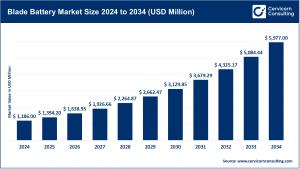Market Overview
The global electric commercial vehicle market is experiencing a significant transformation as governments, businesses, and fleet operators increasingly embrace zero-emission transportation solutions. Covering trucks, buses, vans, and light commercial vehicles, this market growth is propelled by stringent decarbonization targets, urban air quality improvement initiatives, and broader sustainability objectives. In 2024, the market was valued at USD 70.92 billion and is projected to reach approximately USD 602.44 billion by 2034, reflecting a robust CAGR of 23.85% between 2025 and 2034.
Key Market Trends
-
Surge in Heavy-Duty Electrification: Electric truck sales outpaced electric buses in 2023, with 54,000 units sold globally, led by China contributing 70% of this volume. This highlights the increasing adoption of ECVs in logistics and freight sectors.
-
China’s Global Expansion: China sold over 11 million EVs annually, with major manufacturers such as BYD, Geely, and SAIC expanding internationally, boosting global ECV availability.
-
Regulatory and Infrastructure Developments: Regions like North America and Europe are tightening emission norms. In the U.S., heavy-duty truck CO2 emissions are expected to reduce by up to 60% by 2032, accelerating fleet electrification.
-
Integration of Digital & Fleet Intelligence: AI-powered fleet management, predictive maintenance systems, and connected charging networks are optimizing efficiency while lowering total ownership costs.
-
Advances in Battery Technology: Falling lithium-ion battery costs and higher energy density are extending driving ranges, reducing vehicle costs, and supporting wider ECV adoption.
Market Drivers
-
Stringent Environmental Regulations: Global emission standards and low-emission zones are incentivizing fleets to switch to electric vehicles.
-
Cost Efficiency: ECVs offer reduced fuel consumption and maintenance costs compared to traditional vehicles, making them financially attractive.
-
Expansion of Charging Infrastructure: Growth in both public and private charging networks facilitates adoption across urban and regional transport sectors.
-
Technological Innovations: Improvements in battery chemistries (NMC, LFP, solid-state) and digital fleet management solutions enhance vehicle performance and operational efficiency.
-
Sustainability Preferences: Businesses and consumers increasingly favor clean energy solutions due to rising environmental awareness and corporate social responsibility.
Impact of Trends and Drivers
These factors are accelerating ECV uptake across regions and vehicle types. In 2024, the Asia-Pacific region led with a 46.7% revenue share, while battery electric vehicles (BEVs) accounted for 51.4% of propulsion-based revenue. Electric buses captured a 38.8% share, and vehicles with 100–250 kW power output represented 48% of revenue, reflecting strong demand across diverse commercial applications.
Challenges & Opportunities
-
Challenges: High upfront costs, uneven charging infrastructure, and battery disposal issues remain significant hurdles.
-
Opportunities: Growth in last-mile delivery fleets, supportive government incentives, and AI-enabled fleet optimization present substantial growth potential.
Future Outlook
The ECV market is set for remarkable growth, projected to reach USD 602.44 billion by 2034. Continued advancements in battery technologies, expansion of charging infrastructure, and adoption of digital fleet management solutions will drive ECV penetration, especially in logistics, public transport, and last-mile delivery, positioning electric commercial vehicles as a key pillar of sustainable transport.
Source: Cervicorn Consulting

